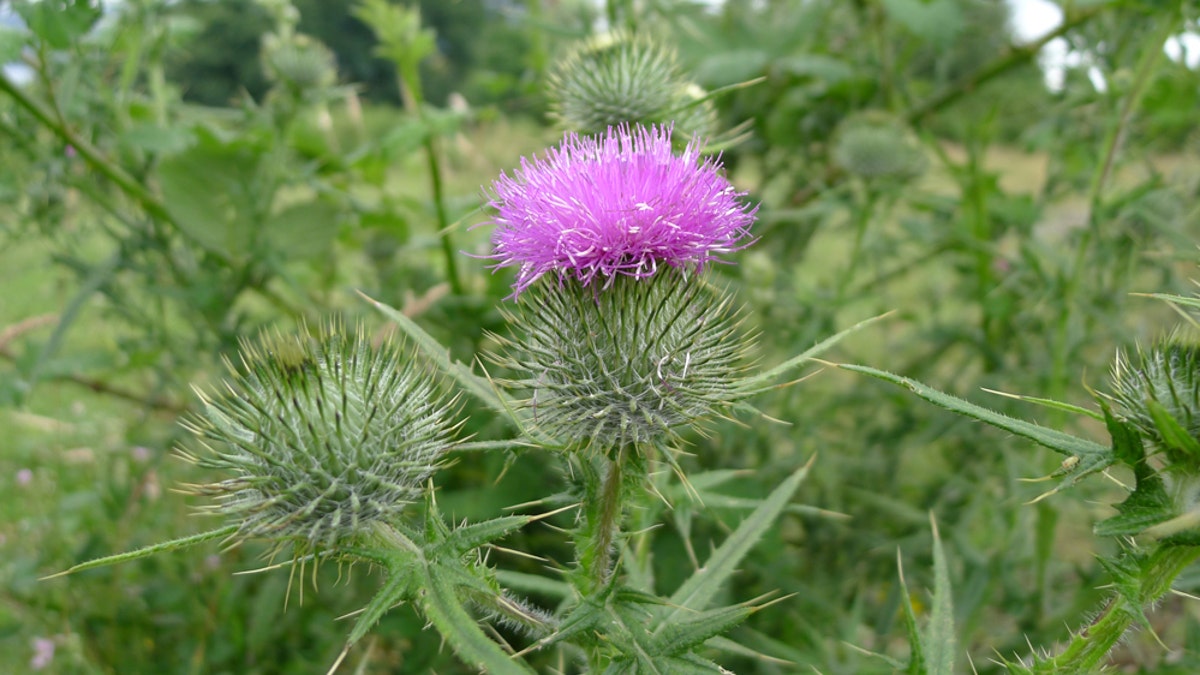
It’s way too easy to eat fatty food and rich desserts. And after over-indulging, many people want to detoxify, to rid the body of that heavy feeling. The best and quickest way to do so is to rid the liver of unwanted fats and accumulated digestive by-products.
And the best way to do that is with milk thistle.
Milk thistle is Silybum marianum. Silybum derives from the Greek word sillybon, which means tuft. The flower of milk thistle looks like a purple tuft. Milk thistle, or Silybum marianum, is native to southern Europe and southern Russia, and is common throughout North and South America, South Australia and Central Europe. Milk thistle is a biennial plant up to 10 feet in height, easily recognized by its brilliant reddish-purple flowers and large prickly leaves. The plant, most notably its seeds, contains a complex of therapeutic compounds known collectively as silymarin.
Milk thistle grows wild in Europe and North America, India, China, South America, Mexico, Australia and Africa. The plant is cultivated in Europe and the United States, in areas whose altitudes range from sea level to 1000 feet. The plant matures in less than a year. Primarily, milk thistle’s large, shiny brown seeds are used to make therapeutic preparations. However, in folk medicine the leaves and flowers are also used.
As an herbal remedy, milk thistle in the form of standardized extracts made from the seeds of the plant, is used for liver cleansing, protective and therapeutic purposes. Milk thistle tea is also used for the same purposes. Milk thistle is widely used throughout Europe for liver ailments including hepatitis A, alcoholic cirrhosis, and exposure to hazardous chemicals. It is also employed as an effective antidote to the otherwise fatally poisonous “death cap” mushroom, Amanita phalloides. Remarkably, milk thistle helps to repair damage to the liver, and to regenerate liver tissue. For this reason, it is a highly beneficial health aid.
Medicinal History
Milk thistle has been employed as a medicine for at least 2,000 years, primarily for ailments of the liver. The 4th Century BC herbalist Theophrastus, and the 1st Century AD physician Pliny, both mentioned milk thistle. The first significant writings on milk thistle were by 1st century AD Greek physician Dioscorides, who employed the roots to induce vomiting, and boiled the leaves to treat snake bites.
The famous 19th Century herbalist Nicholas Culpepper employed milk thistle for diseases of the liver and bile. In the 19th and 20th century, eclectic physicians in the United States prescribed milk thistle for disorders of the liver, kidneys and spleen, and for varicose veins and pelvic congestion.
Use of milk thistle seed for the treatment of liver ailments was promoted by 19th century German physician Rademacher. Since the late 1930s, German herbal researchers have led scientific investigation into the properties and health benefits of milk thistle.
Today in Europe, milk thistle is widely recognized and employed as a protective and restorative agent for liver damage due to hepatitis, cirrhosis, alcohol, drugs, and environmental toxins. In France, Germany, Hungary and Greece, various preparations of milk thistle are employed for a wide variety of health complaints related to liver function. These uses are becoming increasingly popular in the United States due to keen interest in natural remedies.
How It Works
Silymarin in milk thistle has been shown to inhibit damage from toxic substances including alcohol, drugs and other chemicals. Silymarin stabilizes cell membranes in the liver, thus minimizing or inhibiting cell damage due to insult from harmful agents. Silymarin not only shows protective power, but demonstrates specific activity in regenerating liver cells as well.
Some of silymarin’s protective activity is as an antioxidant. In this role, silymarin neutralizes harmful substances called free radicals that can damage cells. Specifically, silymarin protects oxidative damage to the lipid membrane that surrounds liver cells.
As recommended by Germany’s Commission E, for liver protective and supportive treatment purposes, take 200 – 400 mg of silymarin in doses of 100 – 200 mg of silymarin, two times daily, morning and evening, with sufficient fluids.
Product Choosing/Buying Tips
Look for standardized extracts of milk thistle containing between 100-200mg silymarin per capsule/tablet. Standardized products will clearly state their silymarin values. I favor the product Thistlyn by Nature’s Way, which has been the subject of several human clinical studies.
For herbal tea, I’d suggest Alvita brand Milk Thistle, found in most natural food stores. Drink a couple of cups daily to rid your liver of unwanted gunk.
Science Update
A review of 36 silymarin studies found that silymarin from milk thistle demonstrates cell protective activity in the liver, and reduces risk of mortality in cases of cirrhosis. The review further suggested that silymarin may be specifically beneficial in cases of alcohol-related cirrhosis.
Fun Facts/Trivia
• The name Mary thistle or St. Mary thistle, originates from a legend that Mary, while nursing the infant Jesus, spilled some breast milk on the plant, and that this resulted in the characteristic white veins which occur in the leaves.
• According to ancient legend, milk thistle was dedicated to Freya, the Norse goddess Freya, the Norse goddess of love, marriage and fertility.
Chris Kilham is a medicine hunter who researches natural remedies all over the world, from the Amazon to Siberia. He teaches ethnobotany at the University of Massachusetts Amherst, where he is Explorer In Residence. Chris advises herbal, cosmetic and pharmaceutical companies and is a regular guest on radio and TV programs worldwide. His field research is largely sponsored by Naturex of Avignon, France. Read more at www.MedicineHunter.com
Follow us on twitter.com/foxnewslatino
Like us at facebook.com/foxnewslatino
